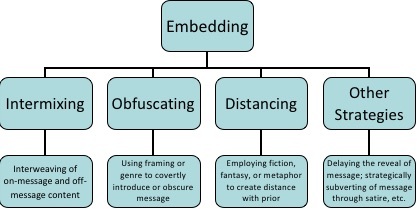Increasingly, persuasive games have been created that depict an argument or point of view on serious issues such as poverty, politics, equality or business ethics.
How can these games be created to be effective in delivering a persuasive message, taking the psychology of polarization in mind?
A Embedded Design Model
Geoff Kaufman (faculty at Carnegie Mellon University), Mary Flanagan (faculty at Dartmouth University), and Max Seidman (game designer) have published research on how to most effectively embed persuasive messages in games. In their research, they have determined that “serious issues in a literal, explicit fashion are far less likely to succeed in changing attitudes or behaviors than are games that take the more ‘stealthy’ approach of embedding persuasive messages within a game’s content or context.” (Kaufman et al, 2015).
Their “Embedded Design” model is an approach based upon effective psychology to present persuasive content in a way that circumvents players’ psychological defenses. It allows players to become more receptive for internalizing the game design’s intended message, and importantly, keeps the game fun and enjoyable.
Three original “embedding” strategies are presented:

- Intermixing: balancing “on-message” and “off-message” content to render the former less overt or threatening; examples include games such as Awkward Moment (Tiltfactor), which explores bias against women in STEM fields; or EcoChains: Arctic Life (Jogolabs), which teaches the effects of climate change on an ecosystem.
- Obfuscating: using framing devices or genres that divert expectations or focus away from the game’s persuasive intent; examples include Buffalo (Tiltfactor), a name dropping party game that explores stereotypes.
- Distancing: employing fiction and metaphor to increase the psychological gap between players’ identities and beliefs and the game’s characters and persuasive content. Examples include: Train (Brenda Romero), a game about the Holocaust.
References
Links
- https://www.researchgate.net/figure/The-Embedded-Design-Model_fig1_319995249
I teach game design and educational technology courses at Teachers College, Columbia University in New York City. You can reach me at GAMES at tc dot columbia dot edu.

